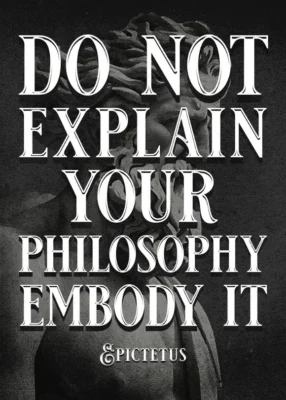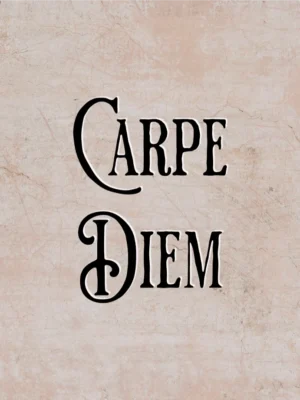“The tranquility that comes when you stop caring what they say. Or think, or do. Only what you do.” – Marcus Aurelius‘s powerful words remind us that dwelling on past regrets only chains us to moments we can’t change. Often people experience regret as one of their most frequent negative emotions. But stoicism developed profound strategies for transforming regret into wisdom; we’ll see those in modern practice!
Understanding Regret Through a Stoic Lens
The Stoic definition of regret and modern differences
The Stoics viewed regret not as an emotional burden to carry, but as a signal from our rational mind that we have new information or wisdom that could have led to better choices. Unlike modern interpretations that often frame regret as a form of emotional self-punishment or rumination, the Stoic view is more practical – it’s simply feedback that can inform future actions. Think of it like a GPS recalculating your route rather than berating you for making a wrong turn.
Epictetus's dichotomy of control and past actions
Epictetus taught that we should focus only on what’s within our control and accept what isn’t. When it comes to past actions, this principle becomes particularly powerful. We cannot control:
- The past actions themselves (they’re already done)
- Other people’s responses to those actions
- The circumstances that led to those moments
We can control:
- Our current interpretation of past events
- What we learn from these experiences
- How we apply these lessons going forward
- Our present actions to make amends if necessary
The distinction between productive and unproductive regret
Productive regret serves as a teacher. It:
- Identifies specific actions or decisions we can improve
- Motivates concrete changes in behavior
- Leads to clear action steps
- Has a defined endpoint
Unproductive regret becomes a prison. It:
- Focuses on unchangeable circumstances
- Creates cycles of self-blame without solutions
- Dwells on “what-ifs” that can’t be answered
- Has no clear resolution point
The Stoic view of regret as growth opportunity
The Stoics understood that personal growth requires honest self-assessment. They saw regret as valuable data about our values and judgment. When we regret something, it often reveals:
- A misalignment between our actions and our values
- A gap in our knowledge or understanding at the time
- An opportunity to strengthen our character
- A chance to develop better decision-making frameworks
The key is to transform regret from a source of pain into a source of wisdom. As Marcus Aurelius suggested, every obstacle can be turned into an opportunity. Regret becomes not a punishment for past mistakes, but a tool for building a stronger character and making better choices in the future.
This approach frees us from the cycle of self-recrimination while still allowing us to learn and grow from our experiences. It’s a practical philosophy that acknowledges our humanity while providing a constructive path forward.
The Stoic Practice of Negative Visualization (Premeditatio Malorum)
Let me break down this powerful Stoic practice and how it relates to managing regret.
Understanding Premeditatio Malorum
The Stoic practice of negative visualization (premeditatio malorum) involves deliberately imagining challenging scenarios or outcomes. When applied to regret, it works by helping us understand that even our mistakes and regrets are often far from the worst possible outcomes. This creates a powerful shift in perspective.
How It Reduces the Sting of Past Mistakes
Imagine you regret a failed business venture. Through negative visualization, you might contemplate:
- What if you had lost everything, not just some investments?
- What if the failure had affected your family’s basic needs?
- What if you had never tried at all, living with the regret of inaction?
By exploring these worse scenarios, your actual situation often becomes more manageable. You realize that:
- You survived and learned from the experience
- You still have resources and opportunities
- The very fact that you can feel regret means you’ve grown wiser
Practical Exercises
The "What's Truly Worst" Exercise
- Write down your current regret
- Imagine progressively worse versions of what happened
- List what you still have despite the mistake
- Identify the learning opportunities that emerged
The "Alternative Timeline" Practice
- Visualize three different ways the situation could have been worse
- Detail the specific challenges each scenario would present
- Compare these to your current reality
- Note the resources and opportunities you still possess
The "Gratitude Through Contrast" Method
- Imagine losing everything you gained from the experience
- Consider how the mistake protected you from worse choices
- List the relationships or insights that emerged from the challenge
Building Resilience Against Future Regrets
- Developing better decision-making frameworks
- Creating realistic expectations about outcomes
- Preparing emotionally for various possibilities
- Building confidence in handling challenges
Real-World Examples
Career Change Regret
Sarah regretted leaving a stable corporate job for a startup that failed. Through negative visualization, she:
- Imagined never having tried entrepreneurship
- Considering the skills she wouldn’t have developed
- Realized the professional network she built Result: Transformed her regret into appreciation for the growth opportunity
Relationship Decision
Mark regretted ending a long-term relationship. Using this practice, he:
- Visualized staying in an unfulfilling partnership
- Considering the personal growth he would have missed
- Recognized the clarity he gained about his needs Result: Shifted from regret to understanding it as a necessary step
Investment Loss
David lost money in a market downturn. Through negative visualization:
- Imagined if he had invested everything
- Considered if he hadn’t started investing at all
- Recognized the financial literacy he developed Result: Transformed regret into valuable investment experience
Advanced Applications
1. Regular Practice Schedule
- Set aside 10 minutes daily
- Journal about potential challenges
- Review past visualizations to track growth
2. Decision-Making Tool
- Before major decisions, visualize worst outcomes
- Create contingency plans
- Build confidence in handling various scenarios
3. Emotional Processing
- Use during moments of acute regret
- Practice accepting different outcomes
- Develop emotional resilience
Embracing Amor Fati: Love of Fate
Let me break down this profound Stoic concept and how it can transform our relationship with regret and past events.
Understanding Amor Fati
“Amor Fati” literally means “love of fate” or “love of what happens.” It’s more than mere acceptance – it’s actively embracing everything that has occurred in your life, including mistakes and regrets. The Stoics believed that truly loving what happens, rather than just tolerating it, leads to profound inner peace and wisdom.
Think of life as a tapestry – every thread, even the dark ones we regret, creates the complete picture. Without those darker threads, the pattern would be incomplete.
Marcus Aurelius's Practice of Radical Acceptance
Marcus Aurelius demonstrated this principle throughout his “Meditations.” He faced numerous challenges as Emperor, yet consistently wrote about accepting and even welcoming difficulties. His approach included:
- Viewing obstacles as opportunities (“The impediment to action advances action”)
- Accepting nature’s course (“Whatever happens is right”)
- Finding purpose in adversity (“What stands in the way becomes the way”)
He practiced this by:
- Writing daily reflections on challenging events
- Actively seeking the benefit in every situation
- Viewing setbacks as tests of character
- Accepting both praise and criticism with equanimity
Techniques for Reframing Past Events
1. The Necessary Path Exercise
- List events you regret
- For each event, identify subsequent positive developments
- Connect how these positives could only have emerged from that specific path
- Write a narrative showing how each step was necessary for your growth
2. The Gratitude Flip
- Take a regretful situation
- List every skill, insight, or relationship it brought into your life
- Consider how these benefits might not have come any other way
- Practice feeling genuine thankfulness for the experience
3. The Wisdom Mining Practice
- Examine past “mistakes” as if they were intentional lessons
- Detail what each experience taught you about yourself
- Identify how this knowledge has protected you from larger mistakes
- Document how you’ve applied these lessons
The Paradox of Freedom Through Acceptance
This is where Amor Fati becomes truly transformative. The paradox is that by fully accepting and even loving what has happened, we become free from its emotional hold on us. It works because:
1. Resistance Creates Suffering
- Fighting against past events drains energy
- Acceptance releases the energy for present action
- Loving what happened eliminates the internal conflict
2. Acceptance Enables Change
- When we accept our past fully, we see clearly what needs to change
- Energy shifts from regret to constructive action
- We gain the clarity to make better choices
3. Love Transforms Perspective
- What we love can’t torment us
- Loving our fate includes loving our mistakes
- This love transforms regret into wisdom
Think of it like learning to swim – fighting against the water makes you sink, while accepting and working with it allows you to move freely.
An Example of Transformation
Consider someone who regrets not pursuing their passion earlier in life. Through Amor Fati:
- Instead of viewing years as “wasted,” see them as necessary preparation
- Recognize how previous experiences inform their current pursuit
- Appreciate how the delay created unique insights and opportunities
- Transform regret into gratitude for the perfect timing of their journey
Watch our Video on How to overcome regret Stoic Way
The Present Moment Focus
Let me explain how the Stoics approached present-moment awareness and how we can apply these principles to break free from regret.
The Stoic Emphasis on the Present Moment
The Stoics understood a fundamental truth: the present moment is our only point of power. As Marcus Aurelius wrote, “Every moment think steadily…to do what you have in hand with perfect and simple dignity.” The focus is on the present because:
- It’s our only point of action
- The past and future exist only in our minds
- All change and growth happen in the now
- Present awareness allows clear judgment
Breaking the Cycle of Rumination
The "Three Time Zones" Practice
- Notice when you’re dwelling on the past
- Identify what aspect of the present you’re avoiding
- Ask: “What action can I take right now?”
- Focus entirely on that immediate action
The "Present Anchor" Technique
- When regretful thoughts arise, immediately notice:
- Three things you can see
- Two things you can hear
- One thing you can feel physically
- This grounds you in the present moment
The "Action Over Analysis" Method
- Set a timer for 2 minutes when caught in regret
- Write down one specific action you can take
- Immediately take that action, no matter how small
- Focus entirely on the physical sensations of doing
Using Mindfulness to Disconnect from Past-Focused Thinking
The Body Scan Practice
- Start at your feet and move upward
- Notice physical sensations without judgment
- When regretful thoughts intrude, return to body awareness
- This breaks the mental cycle of regret
The "Thought Stream" Exercise
- Imagine your thoughts as leaves on a stream
- Watch regretful thoughts float by without engaging
- Notice how thoughts naturally come and go
- Return to watching when you get caught in a thought
The "Present Task" Focus
- Choose any simple activity (washing dishes, walking)
- Engage fully with the physical experience
- When regret arises, redirect attention to sensory details
- Practice making the mundane fascinating
Daily Practices for Strengthening Present-Moment Awareness
Morning Intention Setting
- Begin each day by stating: “I have power only in this moment”
- Set three specific present-focused goals
- Plan concrete actions for each goal
- Review these intentions hourly
Mindful Transitions
- Between activities, pause for three breaths
- Notice your physical position in space
- Consciously choose your next action
- Move with full awareness
Evening Review
- Note moments when you stayed present
- Identify triggers that pulled you into past-thinking
- Plan specific strategies for tomorrow
- End with gratitude for today’s experiences
"Present Moment Bells"
- Set random reminders throughout the day
- When they ring, immediately notice:
- Your posture
- Your breath
- Your immediate environment
- Your current task
- Adjust anything needed to remain present
Practical Integration Tips
- Start with 5-minute practice sessions
- Gradually increase duration as it becomes natural
- Use physical reminders (bracelet, phone alerts)
- Create accountability through daily logging
- Celebrate small wins in maintaining presence
Taking Meaningful Action
Let me break down how to transform regret into purposeful action using Stoic principles.
The Stoic Analysis Framework
- Identify the specific regret
- Extract the core lesson or principle
- Define what could have been done differently
- Create specific action steps for similar future situations
The "Three Questions" Method
- What exactly went wrong?
- What was within my control?
- What specific actions can I take now?
This converts vague regret into clear direction. For example:
Regret: “I wish I had saved more money earlier”
Lesson: Understanding financial planning importance
Action: Set up automatic savings today + create a monthly budget
Future Prevention: Regular financial reviews
Stoic Practices for Making Amends
1. Direct Action Approach
- Acknowledge the mistake without excuses
- Communicate clearly with affected parties
- Take immediate corrective action where possible
- Focus on what can be done now, not what should have been done
2. The Repair Process
- Assess the impact of your actions
- Identify who was affected
- Create a specific plan to address harm
- Take concrete steps to prevent repetition
Focused Action Over Contemplation
The "Next Right Step" Practice
- Instead of analyzing the entire situation, identify one clear next action
- Take that action immediately, no matter how small
- Build momentum through consistent small steps
- Evaluate results and adjust course as needed
Example
Instead of dwelling on a damaged relationship:
- Write one message of acknowledgment
- Schedule one conversation
- Make one specific commitment
- Follow through immediately
Creating a Personal Framework
1. The Learning Template
Step 1: Situation Analysis
- What happened?
- What were the key decision points?
- What information did I have/lack?
Step 2: Impact Assessment
- Who was affected?
- What were the consequences?
- What opportunities were lost/gained?
Step 3: Action Plan
- Immediate actions needed
- Long-term changes required
- Prevention strategies for the future
2. Implementation System
- Keep a “lessons learned” journal
- Review entries monthly
- Track patterns and themes
- Update your decision-making criteria
3. Progress Tracking
- Document specific actions taken
- Note outcomes and results
- Adjust approaches based on feedback
- Celebrate progress and growth
Developing Stoic Self-Compassion
Let me explain how to develop self-compassion through a Stoic lens while maintaining personal accountability.
How Stoicism Promotes Healthy Self-Reflection
The Stoics believed in objective self-assessment without emotional self-punishment. They taught that our past actions were made with the wisdom we had at the time – not the wisdom we have now. This perspective allows us to:
- Examine our actions honestly without shame
- Acknowledge mistakes as learning opportunities
- View our past self as someone who was still growing
- Separate our actions from our worth as a human being
Techniques for Cultivating Self-Forgiveness
The "Past Self as Student" Practice
- Write a letter to your past self as a wise teacher
- Acknowledge what they didn’t know yet
- Share what you’ve learned since then
- Express gratitude for the lessons their mistakes taught you
The "Universal Human Experience" Exercise
- Identify great figures who made similar mistakes
- Study how they moved forward
- Recognize that imperfection is part of growth
- Connect your experience to the shared human journey
The "Wisdom Gained" Inventory
- List what each regret taught you
- Detail how these lessons shaped your character
- Document how you’ve applied this wisdom
- Track the positive impact of these learnings
Balancing Accountability with Emotional Resilience
1. The Two-Column Method

2. The Forward Focus Practice
- Acknowledge the mistake clearly
- Define specific corrective actions
- Set measurable improvement goals
- Create accountability systems
3. The Resilience Building Process
- Separate identity from actions
- Recognize growth through challenge
- Build support systems
- Maintain perspective on progress
Practical Exercises for Building Self-Compassion
Daily Self-Reflection Practice
Morning
- Set intentions for self-kindness
- Identify potential challenges
- Prepare compassionate responses
Evening
- Review actions without judgment
- Note lessons learned
- Acknowledge growth and effort
The "Compassionate Observer" Exercise
- Describe your situation as if helping a friend
- Notice any harsh self-talk
- Reframe criticism into constructive guidance
- Practice speaking to yourself with understanding
The "Growth Timeline" Practice
- Create a timeline of past challenges
- Mark key learning moments
- Note character strengths developed
- Appreciate your journey of growth
Weekly Wisdom Integration
- Review recent challenges
- Document new insights
- Plan specific applications
- Celebrate small improvements
Stoic Decision-Making Frameworks to Prevent Future Regrets
Dichotomy of Control
- Focus only on what you can directly influence
- Accept external circumstances
- Channel energy into personal choices and responses
Premeditation of Adversity
- Anticipate potential challenges
- Mentally rehearse difficult scenarios
- Develop adaptive strategies in advance
Role of Virtue in Decision-Making
Core Stoic Virtues
- Wisdom: Rational, informed choices
- Courage: Facing challenges authentically
- Justice: Ethical considerations
- Temperance: Balanced, moderate actions
Decision Checklist
- Does this align with my core values?
- Will I be proud of this choice long-term?
- Am I acting with integrity?
- What would my best self choose?
Creating Personal Principles
1. Personal Virtue Code
- Define 3-5 core personal principles
- Link each to specific behaviors
- Regular self-assessment against these standards
2. Decision-Making Filters
- Prioritize long-term growth over short-term comfort
- Maintain consistency between beliefs and actions
- Embrace discomfort for personal development
Long-Term Intentional Living Strategies
1. Continuous Learning Approach
- Regular self-reflection
- Seek feedback
- Adapt and evolve principles
2. Intentional Practice
- Daily journaling
- Periodic life reviews
- Conscious skill development
3. Resilience Building
- Embrace challenges as growth opportunities
- Develop emotional flexibility
- Maintain perspective during difficulties
Core Implementation
- Start small
- Build consistent habits
- Embrace imperfect progress






